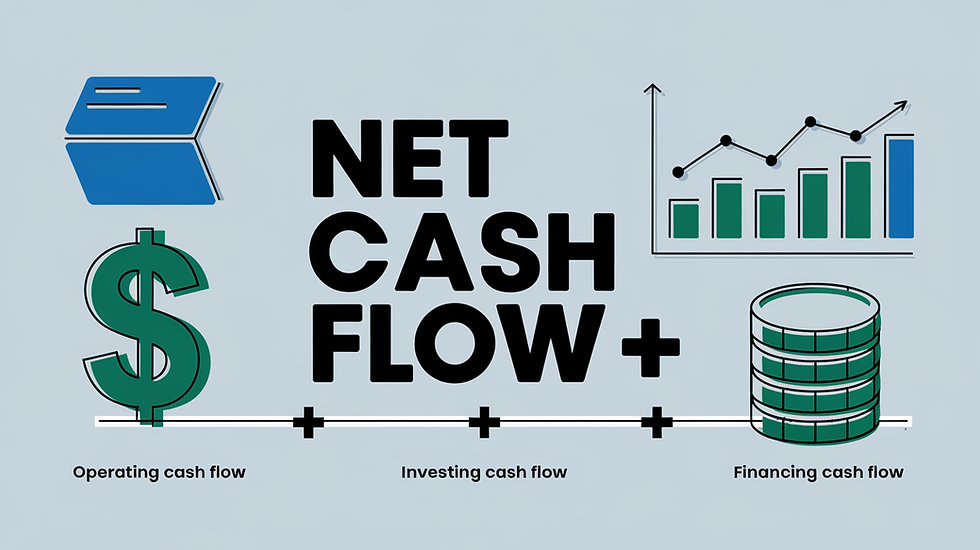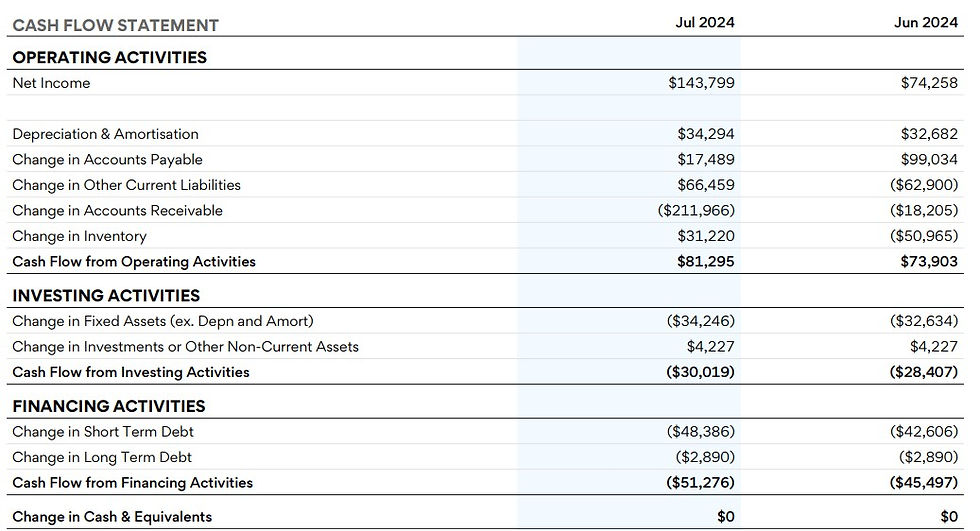The Cash Flow Statement: What It Is and Why It Matters
- Colin Murray

- Jan 30
- 5 min read
Updated: Mar 2

Too many small business owners only focus on profit, believing that if their income statement looks good, their business must be financially healthy.
But a profitable business can still fail due to cash shortages. In fact, 82% of small business failures are a direct result of cash flow problems.
This is why the cash flow statement (CFS) is one of the most important financial reports a business owner can use.
Unlike the profit and loss statement, which shows profitability, or the balance sheet, which provides a snapshot of assets and liabilities, the cash flow statement tracks the actual movement of cash in and out of your business.
This statement reveals whether your business is generating enough cash to sustain operations, grow, and meet financial obligations.
In this deep dive, we’ll break down how to read and interpret a cash flow statement, why it matters, and how to use it to improve financial decision-making.
What is a Cash Flow Statement?
The cash flow statement provides a detailed breakdown of how cash enters and exits a business during a specific period.
It’s divided into three sections: operating activities, investing activities, and financing activities. Each section helps business owners understand where their cash is coming from and how it is being used.
A company can have positive net income but still struggle with cash flow. This is because of certain accounting treatments used in accrual accounting.
The key thing to remember is that profit does not equal cash flow.
For example, if a business records high revenue but most of its sales are made on credit, the money isn’t actually in the bank. A cash flow statement helps identify these discrepancies.
Consider this example:
A company generates $100,000 in sales but only collects $60,000 in cash during the month.
At the same time, it has $50,000 in expenses, with $45,000 paid in cash and $5,000 on credit.
Although it appears profitable ($100,000 revenue - $50,000 expenses = $50,000 profit), its net cash inflow is only $15,000 ($60,000 cash in - $45,000 cash out).

Breaking Down the Cash Flow Statement
Operating Activities
The operating activities section reflects cash generated or used in day-to-day business operations. It includes revenue from sales, payments to suppliers, employee wages, and other operating expenses.
For example, if a business reports $50,000 in net income, adds back $5,000 in depreciation, and has a $10,000 increase in accounts receivable (meaning customers owe more and cash collection is slower), the cash flow from operations would be:
$50,000 + $5,000 - $10,000 = $45,000
A positive cash flow from operations indicates that the business is generating enough cash to sustain operations. A negative cash flow may suggest inefficiencies or the need to raise additional funds.
Investing Activities
The investing activities section records cash spent on or received from investments in assets. This includes purchasing equipment, acquiring property, or selling investments.
A business investing in new equipment might show negative cash flow from investing activities, which isn’t necessarily a bad sign—it may indicate growth and expansion.
For example:
A company purchases machinery for $30,000.
It also sells an old vehicle for $10,000.
Net cash flow from investing activities would be:
($30,000) + $10,000 = $20,000
Financing Activities
This section shows cash transactions related to borrowing, repaying loans, issuing shares, or paying dividends.
A positive financing cash flow may indicate the business is raising capital for expansion, while a negative financing cash flow may mean debt repayment or dividend distribution.
A business that secures a $50,000 loan and repays $10,000 in principal will report:
$50,000 - $10,000 = $40,000
Why the Cash Flow Statement Matters
1. Helps Prevent Cash Shortages
As we found out above, 82% of small business failures are due to cash flow problems. The CFS helps identify potential shortfalls in advance.
If a business sees that its operating cash flow is consistently negative, it can adjust spending, speed up collections, or secure financing before running into trouble.
2. Aids in Financial Planning
The CFS helps business owners make informed decisions about hiring, inventory purchases, and expansion. If cash flow is tight, delaying a major purchase could prevent liquidity issues.
3. Makes It Easier to Secure Loans and Investors
Banks and investors evaluate cash flow statements to determine if a business can manage debt and sustain growth. A strong operating cash flow reassures lenders that the business is capable of repaying loans.
4. Identifies Financial Red Flags Early
If a company has consistent negative cash flow from operations but is financing activities through loans, it may be relying too heavily on borrowed capital. This could signal financial instability.

How to Analyze a Cash Flow Statement
Understanding the numbers is only the first step—interpreting trends is where the real value lies. A single data point rarely provides enough information to make an informed decision.
Step 1: Compare Cash Flow Trends Over Time
Reviewing cash flow statements over several months or quarters can reveal whether cash flow is improving or deteriorating.
Step 2: Assess the Net Cash Flow Position
A business with consistently negative net cash flow needs to reassess its cost structure, pricing strategy, or collection processes.
Step 3: Calculate Free Cash Flow (FCF)
Free cash flow (FCF) represents the cash remaining after capital expenditures, showing whether a business can fund growth without external financing.
A positive FCF allows for reinvestment and debt repayment, while a negative FCF may indicate the need for financing.
Step 4: Identify Areas for Improvement
If receivables are too high, consider tightening payment terms.
If operating cash flow is low but profit is high, evaluate collection policies and expense timing.
If cash flow from investing activities is negative due to heavy capital expenditures, ensure the business has sufficient reserves or financing options.
Common Mistakes to Avoid
1. Confusing Profit with Cash Flow
Just because a company is profitable doesn’t mean it has sufficient cash. A business with large accounts receivable balances may struggle to pay bills despite showing a profit.
2. Ignoring Changes in Working Capital
A sudden increase in inventory purchases or delayed customer payments can reduce cash flow, even if revenue appears strong.
3. Not Planning for Future Cash Needs
Without forecasting, businesses may run into unexpected cash shortages. Regularly reviewing cash flow trends helps avoid surprises.
Building a 13-week cash flow forecast allows for a balance between short-term operating needs and longer-term planning.
Conclusion
The cash flow statement is more than an accounting document—it’s a powerful tool for understanding and improving financial health.
By monitoring cash flow regularly, businesses can avoid liquidity issues, plan for the future, and make informed financial decisions.
It's Time to Understand Your Cash Flow
Need help understanding and optimizing your cash flow? HighRidge CFO provides expert financial guidance to help small businesses manage their cash flow effectively.
Contact us today to get started!




Comments